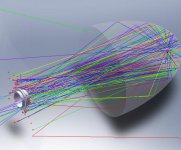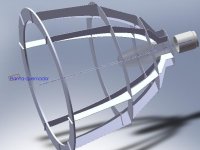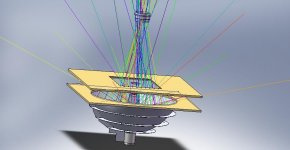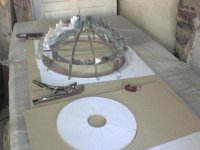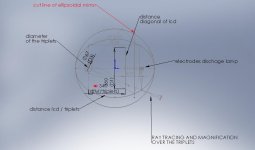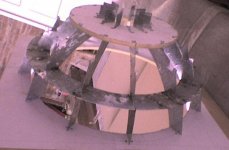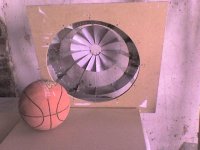CHANGE SIZE AND GEOMETRY
I CHANGE DE GEOMETRY OF THE ELLIPSOIDAL REFLECTOR FOR SEND MORE RAYS TO THE TRIPLETS.
AS YOU SEE A SIMULATION OF RAY TRACE SHOW THE PATH OF THE light.
I CHANGE DE GEOMETRY OF THE ELLIPSOIDAL REFLECTOR FOR SEND MORE RAYS TO THE TRIPLETS.
AS YOU SEE A SIMULATION OF RAY TRACE SHOW THE PATH OF THE light.
shape of desk but a projector without fresnel !!
the work to design a projector without using fresnel follows.
here him step a drawing in accommodation ladder as it is the projector.
he is similar to a small desk.
and according to I create east model will be the chosen one.
the work to design a projector without using fresnel follows.
here him step a drawing in accommodation ladder as it is the projector.
he is similar to a small desk.
and according to I create east model will be the chosen one.
Attachments
Thats an interesting concept, will the lcd sit in the square section then? what about keystone correction? what type of lamp will you use?
Post #5
Thats an interesting concept, will the lcd sit in the square section then? what about keystone correction? what type of lamp will you use?
hi tescorp . yes project put lcd in the square section make of wood . just for hold the lcd.
about de keystone correction not fount a solution . because not have a zone with collimated or (parallels ray) arround lcd.
but i search do this work , by means of a software.
the lamp that try to use will be that follows : arcokolor 400 watt. 6500 k and 25000 lumens output.
is a big lamp . but is very cheap .
using a system without lcd i hope to optain more lumens output.
in few day, when i finish all drawing .
will print the planes in scale 1 : 1 and paste it over the plates and cut all together.
in order to be forming the ellipsoidal mirror.
i will update all step. and problems that appears
i hope you can understand my inglish is very rustic.
and thank you for your interest.
Thats an interesting concept, will the lcd sit in the square section then? what about keystone correction? what type of lamp will you use?
hi tescorp . yes project put lcd in the square section make of wood . just for hold the lcd.
about de keystone correction not fount a solution . because not have a zone with collimated or (parallels ray) arround lcd.
but i search do this work , by means of a software.
the lamp that try to use will be that follows : arcokolor 400 watt. 6500 k and 25000 lumens output.
is a big lamp . but is very cheap .
using a system without lcd i hope to optain more lumens output.
in few day, when i finish all drawing .
will print the planes in scale 1 : 1 and paste it over the plates and cut all together.
in order to be forming the ellipsoidal mirror.
i will update all step. and problems that appears
i hope you can understand my inglish is very rustic.
and thank you for your interest.
Hi, what if you used a second smaller spherical reflector to redirect the divergent rays back through the light source, so they could pass through the triplet too?
I had thought of a computer LCD display with a smart 2 mode backlight: 1 normal use, divergent cone, 2 projection mode, convergent cone, with a lens in its vertex. Placing the LCD after and before the second focus acomplishes just that in your design.
I had thought of a computer LCD display with a smart 2 mode backlight: 1 normal use, divergent cone, 2 projection mode, convergent cone, with a lens in its vertex. Placing the LCD after and before the second focus acomplishes just that in your design.
ELLIPSOIDAL MIRROR CONSTRUCCION
HI !
not need use a secondary reflector .
from my experience actualy think the follow.
The rays of light are focused more on triplet under 2 condition:
1) if the light souce is small.
this is not my case because i using a big lamp.
2) other posiblity is to make the mirror ellipsoidal with a big diameter.
i will show a sckech . there you watch a ray tracing and the magnification thats appens . when ray emerging fron lamp. next Bounce over mirror and Finally reach the triplets lens.
Actually I am not sure if this is going to work.
I have many doubts.
But that makes it interesting.
Jejee.
HI !
not need use a secondary reflector .
from my experience actualy think the follow.
The rays of light are focused more on triplet under 2 condition:
1) if the light souce is small.
this is not my case because i using a big lamp.
2) other posiblity is to make the mirror ellipsoidal with a big diameter.
i will show a sckech . there you watch a ray tracing and the magnification thats appens . when ray emerging fron lamp. next Bounce over mirror and Finally reach the triplets lens.
Actually I am not sure if this is going to work.
I have many doubts.
But that makes it interesting.
Jejee.
Attachments
the Sharp XV-315P has this light system, a large reflector + small LCD (3" LCD) + large lense
An externally hosted image should be here but it was not working when we last tested it.
ywh said:the Sharp XV-315P has this light system, a large reflector + small LCD (3" LCD) + large lense
An externally hosted image should be here but it was not working when we last tested it.
do you have any shots of this projector opened up so we can get a look at the system used? I would like to see the reflector and bulb. seems like everyone is pumping out these little projectors, DIY is so much better.
DIY is so much better !!
Hello everyone;
yes a diy projector es better .
I also I would find a link for check how is inside the "the Sharp XV-315P"
in my case i prefer to do a diy projector . for my personal satisfaction .
and Besides ; if i be in the correct; this diy projector using a lamp with 25000 lumen . the simulation show a 7000 lumens on the area of the triplets.
But I am happy if I reach a real output 2000 lumens. and an uniform light distribution .
I hope to have time to be finalized. and see the results.
Hello everyone;
yes a diy projector es better .
I also I would find a link for check how is inside the "the Sharp XV-315P"
in my case i prefer to do a diy projector . for my personal satisfaction .
and Besides ; if i be in the correct; this diy projector using a lamp with 25000 lumen . the simulation show a 7000 lumens on the area of the triplets.
But I am happy if I reach a real output 2000 lumens. and an uniform light distribution .
I hope to have time to be finalized. and see the results.
Attachments
I am really looking forward to see how this turns out, the less you have in the light path the more lumens you can get out of it. I am always looking for a new design to try. I have built over 130 enclosures for many people. Have you designed an enclosure for this system?
Re: ELLIPSOIDAL MIRROR CONSTRUCCION
1 is of course a general truth. 2 could help by reducing the need for small tolerances in mirror surface manufacture.
Looking at your sketch you lose almost half the light from the arc, because it doesn't hit the mirror in the first place, so it misses the triplet too. That's where a small secondary mirror covering exactly the solid angle of the lost light could help. Some newer bulbs already integrate this trick in their design: half the quartz sphere is made to reflect.
You could also use a round lens to cover the blind cone. It seems to me the opposite of fresnel designs will happen here: you will have a dimmer center than the perifery of the LCD. That secondary optic could help there.
But of course first build the primary mirror, then see how it works. Compared to the fresnel approach you make use of roughly the part of the light lost there, which is more than half, so it should be an improvement.
It will be a challenge to get that big reflecting surface, with both the tolerance and reflectivity. Maybe try aluminium wrap foil?
XIGATON said:HI !
not need use a secondary reflector .
Actually I am not sure if this is going to work.
I have many doubts.
But that makes it interesting.
Jejee.
1 is of course a general truth. 2 could help by reducing the need for small tolerances in mirror surface manufacture.
Looking at your sketch you lose almost half the light from the arc, because it doesn't hit the mirror in the first place, so it misses the triplet too. That's where a small secondary mirror covering exactly the solid angle of the lost light could help. Some newer bulbs already integrate this trick in their design: half the quartz sphere is made to reflect.
You could also use a round lens to cover the blind cone. It seems to me the opposite of fresnel designs will happen here: you will have a dimmer center than the perifery of the LCD. That secondary optic could help there.
But of course first build the primary mirror, then see how it works. Compared to the fresnel approach you make use of roughly the part of the light lost there, which is more than half, so it should be an improvement.
It will be a challenge to get that big reflecting surface, with both the tolerance and reflectivity. Maybe try aluminium wrap foil?
Post #15
I am really looking forward to see how this turns out, the less you have in the light path the more lumens you can get out of it. I am always looking for a new design to try. I have built over 130 enclosures for many people. Have you designed an enclosure for this system?
I did a projector using fresnel.But it will not be very happy.
About this system. It is the first to attempt to do.
I am really looking forward to see how this turns out, the less you have in the light path the more lumens you can get out of it. I am always looking for a new design to try. I have built over 130 enclosures for many people. Have you designed an enclosure for this system?
I did a projector using fresnel.But it will not be very happy.
About this system. It is the first to attempt to do.
Re: Re: ELLIPSOIDAL MIRROR CONSTRUCCION
Their remarks are very accurate.
And then I would be interested to see how put a mirror assistant next time.
about the firs remarks. "you lose almost half the light from the arc, because it doesn't hit the mirror in the first place"
This happens because the line cut of the ellipsoidal mirror is linked with The size of lcd .
and the other remarks "so it misses the triplet too"
is too correct. the problem was that send all rays inside the triplets .
is necessary a mirror diameter too big . and then prefer lost a porcent light outside of the triplets.
In order to make the model more compact.
Their remarks are very useful.
I am taking notes.
tanks !!
zzonbi said:
1 is of course a general truth. 2 could help by reducing the need for small tolerances in mirror surface manufacture.
Looking at your sketch you lose almost half the light from the arc, because it doesn't hit the mirror in the first place, so it misses the triplet too. That's where a small secondary mirror covering exactly the solid angle of the lost light could help. Some newer bulbs already integrate this trick in their design: half the quartz sphere is made to reflect.
You could also use a round lens to cover the blind cone. It seems to me the opposite of fresnel designs will happen here: you will have a dimmer center than the perifery of the LCD. That secondary optic could help there.
But of course first build the primary mirror, then see how it works. Compared to the fresnel approach you make use of roughly the part of the light lost there, which is more than half, so it should be an improvement.
It will be a challenge to get that big reflecting surface, with both the tolerance and reflectivity. Maybe try aluminium wrap foil?
Their remarks are very accurate.
And then I would be interested to see how put a mirror assistant next time.
about the firs remarks. "you lose almost half the light from the arc, because it doesn't hit the mirror in the first place"
This happens because the line cut of the ellipsoidal mirror is linked with The size of lcd .
and the other remarks "so it misses the triplet too"
is too correct. the problem was that send all rays inside the triplets .
is necessary a mirror diameter too big . and then prefer lost a porcent light outside of the triplets.
In order to make the model more compact.
Their remarks are very useful.
I am taking notes.
tanks !!
What are you going to use for the reflective surface inside this shell?
What is the focal length of this?
What is the focal length of this?
TESCORP said:
do you have any shots of this projector opened up so we can get a look at the system used? I would like to see the reflector and bulb. seems like everyone is pumping out these little projectors, DIY is so much better.
An externally hosted image should be here but it was not working when we last tested it.
An externally hosted image should be here but it was not working when we last tested it.
- Status
- Not open for further replies.
- Home
- General Interest
- Everything Else
- The Moving Image
- DIY Projectors
- projector without fresnel
